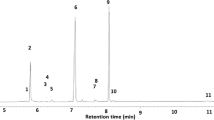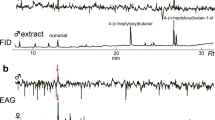Abstract
The study of insect semiochemicals, especially pheromones, is of fundamental importance for the development of strategies for controlling agricultural pests. In this study, volatile compounds involved in the communication between males and females of the fruit fly, Anastrepha obliqua (Diptera: Tephritidae), for mating purposes were characterized to develop attractant formulations for females of this species. Extracts containing volatile compounds released by males of A. obliqua were obtained by the dynamic headspace technique and analyzed by gas chromatography coupled with an electroantennographic detector (GC-EAD) and gas chromatography coupled with mass spectrometry (GC-MS). Twenty-one volatile compounds were identified in the aeration extracts of males. Five of them caused EAD responses from the antennae of females: 1-heptanol, linalool, (Z)-3-nonen-1-ol, (E,Z)-3,6-nonadien-1-ol, and (Z,E)-α-farnesene. Six synthetic mixtures of these compounds, including the five-component blend and all possible four-component blends, were formulated in a biopolymer and used in behavioral bioassays conducted in the laboratory arena with conspecific virgin females. One blend of 1-heptanol, linalool, (Z)-3-nonen-1-ol, and (Z,E)-α-farnesene attracted more females than the collection of volatiles from virgin males used as control. The other mixtures were as attractive to A. obliqua females as the control treatment. This study indicates potential for use of these compounds in monitoring and control strategies for this pest.


Similar content being viewed by others
Data Availability
All relevant data are within the paper and its Supporting Information file.
References
Adams RP (2007) Identification of essential oil components by gas chromatography/mass spectrometry. Allured Publishing Corporation, Illinois
Baker TC (1989) Origin of courtship and sex pheromones of the oriental fruit moth and a discussion of the role of phytochemicals in the evolution of lepidopteran male scents. Phytochemical ecology: allelochemicals, mycotoxins and insect pheromones and allomones. Academia Sinica Monograph Series 9:401–418
Battiste MA, Strekowski L, Vanderbilt DP, Visnick M, King RW, Nation JL (1983) Anastrephin and epianastrephin, novel lactone components isolated from the sex pheromone blend of male Caribbean and Mexican fruit flies. Tetrahedron Lett 24:2611–2614. https://doi.org/10.1016/S0040-4039(00)87958-7
Beyaert I, Wäschke N, Scholz A, Varama M, Reinecke A, Hilker M (2010) Relevance of resource-indicating key volatiles and habitat odour for insect orientation. Anim Behav 79:1077–1086. https://doi.org/10.1016/j.anbehav.2010.02.001
Biasazin TD, Karlsson MF, Hillbur Y, Seyoum E, Dekker T (2014) Identification of host blends that attract the African invasive fruit fly, Bactrocera invadens. J Chem Ecol 40:966–976
Brízová R, Mendonça AL, Vanícková L, Mendonça AL, Da Silva CE, Tomčala A, Paranhos BAJ, Dias VS, Bravo ISJ, Hoskovec M, Kalinová B, Do Nascimento RR (2013) Pheromone analyses of the Anastrepha fraterculus (Diptera:Tephritidae) cryptic species complex. Fla Entomol 96:1107–1115. https://doi.org/10.1653/024.096.0351
Bruce TJA, Pickett JA (2011) Perception of plant volatile blends by herbivorous insects – finding the right mix. Phytochem Rev 72:1605–1611. https://doi.org/10.1016/j.phytochem.2011.04.011
Chuman T, Landolt PJ, Heath RR, Tumlinson JH (1987) Isolation, identification, and synthesis of male-produced sex pheromone of papaya fruit fly, Toxotrypana curvicauda Gerstaecker (Diptera: Tephritidae). J Chem Ecol 13:1979–1992. https://doi.org/10.1007/BF01014680
Cruz-López L, Malo EA, Toledo J, Virgen A, Del Mazo A, Rojas JC (2006) A new potential attractant for Anastrepha obliqua from Spondias mombin fruits. J Chem Ecol 32:351–365. https://doi.org/10.1007/s10886-005-9006-7
Cruz-López L, Malo EA, Rojas JC (2015) Sex pheromone of Anastrepha striata. J Chem Ecol 41:458–464. https://doi.org/10.1007/s10886-015-0581-y
FAO Yearbook (2010) Statistics Division
Gonçalves GB, Silva CE, Mendonça ADL, Vaníčková L, Tomčala A, Nascimento RRD (2013) Pheromone communication in Anastrepha obliqua (Diptera: Tephritidae): a comparison of the volatiles and salivary gland extracts of two wild populations. Fla Entomol 96:1365–1374
González R, Toledo J, Cruz-Lopez L, Virgen A, Santiesteban A, Malo EA (2006) A new blend of white Sapote fruit volatiles as potential attractant to Anastrepha ludens (Diptera: Tephritidae). J Econ Entomol 99:1994–2001. https://doi.org/10.1093/jee/99.6.1994
Heath RR, Landolt PJ, Robacker DC, Dueben BD, Epsky N (2000) Sexual pheromones of tephritid flies: clues to unravel phylogeny and behavior. In: Aluja M, Norrbom AL (eds) Fruit flies (Tephritidae): phylogeny and evolution of behavior. CRC Press LLC, Boca Raton, pp 793–809
Johnston RE (2008) Individual odors and social communication: individual recognition, kin recognition, and scent over marking. Adv Study Behav 38:439–505
Kalinová B, Nascimento RRD, Hoskovec M, Mendonça AL, Silva EL, Freitas MRTD, Cabral-Jr CR, Silva CE, Sant’Ana AEG, Svatoš A (2012) Identification of two components of the female sex pheromone of the sugarcane-borer Diatraea flavipennella (Lepidoptera: Crambidae). J Appl Entomol 136:203–211. https://doi.org/10.1111/j.1439-0418.2011.01625.x
Landolt PJ, Phillips TW (1997) Host plant influences on sex pheromone behavior of Phytophagous insects. Annu Rev Entomol 42:371–391. https://doi.org/10.1146/annurev.ento.42.1.371
Law JH, Regnier FE (1971) Pheromones https://www.annualreviews.org/doi/pdf. https://doi.org/10.1146/annurev.bi.40.070171.002533 Accessed 28 Jun 2020
Lima IS, House PE, Nascimento RRD (2001) Volatile substances from male Anastrepha fraterculus wied. (Diptera: Tephritidae): identification and behavioural activity. J Braz Chem Soc 12:196–201. https://doi.org/10.1590/S0103-50532001000200012
Lima-Mendonça A, Mendonça AL, SanťAn AEG, do Nascimento RR (2014) Semiochemicals of fruit flies of the genus Anastrepha. Quim Nova 37:293–301
Linz J, Baschwitz A, Strutz A, Dweck HKM, Sachse S, Hansson BS, Stensmyr MC (2013) Host plant-driven sensory specialization in Drosophila erecta. Proc R Soc Lond B Biol Sci 280:1–9. https://doi.org/10.1098/rspb.2013.0626
López-Guillén G, López LC, Malo EA, Rojas JC (2011) Olfactory responses of Anastrepha obliqua (Diptera: Tephritidae) to volatiles emitted by calling males. Fla Entomol 94:874–881
Malavasi A (2009) Biologia, ciclo de vida, relação com o hospedeiro, espécies importantes e biogeografia de tefritídeos In: Malavasi, A.; Virginio, J. (Org.). Biologia, monitoramento e controle: V Curso Internacional de Capacitação em Moscas-das-Frutas. Juazeiro, Bahia, pp 1-5
McNeil JN, Millar JG (2012) Chemical communication: pheromone and allelochemical. In: Chapman ed the insects structure and function, 5th edn. Cambridge University Press, New York, pp 857–897
Milet-Pinheiro P, Navarro DMA, De Aquino NC, Ferreira LL, Tavares R, da Silva RDCC, Mendonça AL, Vaníčková L, Mendonça AL, Do Nascimento RR (2015) Identification of male-borne attractants in Anastrepha fraterculus (Diptera: Tephritidae). Chemoecology 25:115–122. https://doi.org/10.1007/s00049-014-0180-3
Naka H, Kubota S, Kuchiki F, Shibasaki H, Yamamoto M, Soejima Y, Arita Y, Ando T (2018) Identification and field attraction of the female sex pheromone of a kiwifruit pest, Nokona feralis (Lepidoptera: Sesiidae). Biosci Biotechnol Biochem 82:1468–1472. https://doi.org/10.1080/09168451.2018.1484274
Nation JL (1975) The sex pheromone blend of Caribbean fruit Fly males: isolation biological activity, and partial chemical characterization. Environ Entomol 4:27–30. https://doi.org/10.1093/ee/4.1.27
Nation JL (1983) Sex pheromone of the Caribbean fruit fly: chemistry and field ecology. In: Miyamoto P, Kearney C (eds) Pesticide chemistry, human welfare and the environment. Pergamon Press, New York, pp 109–110
Nation JL (1990) Biology of pheromone release by male caribbean fruit flies, Anastrepha suspensa (Diptera: Tephritidae). J Chem Ecol 16:553–572. https://doi.org/10.1007/BF01021786
Nishida R, Shelly TE, Kaneshiro KY (1997) Acquisition of female-attracting fragrance by males of Oriental fruit fly from Hawaiian lei flower, Fragraea berteriana. J Chem Ecol 23:2275–2285
Nishida R, Tan KH, Serit M, Lajis NH, Sukari AM, Takahashi S, Fukami H (1988) Accumulation of phenylpropanoids in the rectal glands of males of the oriental fruit-fly, Dacus dorsalis. Experientia 44:534–536. https://doi.org/10.1007/BF01958941
Pires EV, de L Mendonça A, Vaníčková L, Serra NSJ, Silva RCC, Santos DCD, Campos RDS, Sant’Ana AEG, Nascimento RRD (2016) Identification and field and laboratory tests of the sex pheromone of Cerconota anonella Sepp. (Lepidoptera: Oecophoridae). J Appl Entomol 140:72–80. https://doi.org/10.1111/jen.12228
Rasgado MA, Malo EA, Cruz-López L, Rojas JC, Toledo J (2009) Olfactory response of the Mexican fruit Fly (Diptera: Tephritidae) to Citrus aurantium volatiles. J Econ Entomol 102:585–594. https://doi.org/10.1603/029.102.0216
Renou M (2014) Pheromones and general odor perception in insects. In: Mucignat-Caretta C (ed) Neurobiology of chemical communication. Press/Taylor & Francis, Boca Raton, pp 23–33
Reyes H, Malo EA, Toledo J, Cruz-Esteban S, Rojas JC (2017) Physiological state influences the antennal response of Anastrepha obliqua to male and host volatiles. Physiol Entomol 42:17–25. https://doi.org/10.1111/phen.12157
Rocca JR, Nation JL, Strekowski L, Battiste MA (1992) Comparison of volatiles emitted by male caribbean and mexican fruit flies. J Chem Ecol 18:223–244. https://doi.org/10.1007/BF00993755
Roelofs WL, Carde RT (1974) Sex pheromones in the reproductive isolation of lepidopterous species. in M. C. Birch (ed.) Evolutionary genetics of invertebrate behavior, Springer Science Business Media, New York pp. 303–317
Schröder R, Hilker M (2008) The relevance of background odor in resource location by insects: a behavioral approach. BioScience 58:308–316. https://doi.org/10.1641/B580406
Smadja C, Butlin RK (2009) On the scent of speciation: the chemosensory system and its role in premating isolation. Heredity 102:77–97. https://doi.org/10.1038/hdy.2008.55
Steiger S, Schmitt T, Schaefer HM (2011) The origin and dynamic evolution of chemical information transfer. Proc R Soc B 278:970–979. https://doi.org/10.1098/rspb.2010.2285
Symonds MRE, Elgar MA (2008) The evolution of pheromone diversity. Trends Ecol Evol 23:220–228. https://doi.org/10.1016/j.tree.2007.11.009
Vaníčková L, do Nascimento RR, Hoskovec M, Ježková Z, Břízová R, Tomčala A, Kalinová B (2012) Are the wild and laboratory insect populations different in Semiochemical emission? The case of the medfly sex pheromone. J Agric Food Chem 60:7168–7176. https://doi.org/10.1021/jf301474d
Wiley RH (2013) Specificity and multiplicity in the recognition of individuals: implications for the evolution of social behaviour. Biol Rev 88:179–195. https://doi.org/10.1111/j.1469-185X.2012.00246.x
Wyatt TD (2014) Pheromones and animal behavior. Chemical signals and signatures, 2nd edn. Cambridge University Press, Cambridge
Zucchi RA (2000) Espécies de Anastrepha, sinonímias, plantas hospedeiras e parasitóides. In: Malavasi, A., Zucchi, RA (eds). Moscas das frutas de importância econômica no Brasil: Conhecimento básico e aplicado. Holos Editora, Ribeirão Preto, pp 41-48.
Zucchi RA (2007) Diversidad, distribución y hospederos del género Anastrepha en Brasil. In: Ortiz-Hernandéz V. (Ed.). Moscas de la fruta en Latinoamérica (Diptera:Tephritidae): diversidad, biología y manejo. Distrito Federal, México: S y G Editores, p.77–100
Zucchi RA (2012) Fruit flies in Brazil - Hosts and parasitoids of the Mediterranean fruit fly. Available at: www.lea.esalq.usp.br/ceratitis/. Accessed 23 Nov 2018
Acknowledgements
The authors would like to thank the Conselho Nacional de Desenvolvimento Científico e Tecnológico (CNPq) for the financial support given to DMAFN (grant numbers: 422233/2018-8, 303404/2019-1; Ph.D scholarships given to NCA, LLF and RFT and a research fellowships given to RRN and FCAG (grant numbers: 304038/2017-2 and 308858/2019-0 and Coordenação de Aperfeiçoamento de Pessoal de Nível Superior (CAPES) for a MSc scholarship granted to CSS. A patent application has been filed for this discovery.
Funding
This study was supported by Conselho Nacional de Desenvolvimento Científico e Tecnológico (CNPq) (URL: www.cnpq.br) (grant numbers: 304038/2017–2; 422233/2018–8 e 303404/2019–1). NCA, LLF, RFT received fellowships from Conselho Nacional de desenvolvimento Científico e Tecnológico (CNPq) during their Ph.D and CSS was a recipient of a scholarship from Coordenação de Aperfeiçoamento de Pessoal de Nível Superior (CAPES) (URL:www.capes.gov.br) during her Ms.C. RRN. FCAG are CNPq fellows. The funder had no role in study design, data collection and analysis, decision to publish, or preparation of the manuscript.
Author information
Authors and Affiliations
Contributions
Conceived and designed the experiments: Ruth Rufino do Nascimento, Adriana de Lima Mendonça.
Performed the experiments: Nathaly Costa de Aquino, Luana Lima Ferreira, Raphael de Farias Tavares. Claudinete dos Santos Silva.
Analyzed the data: Nathaly Costa de Aquino, Raphael de Farias Tavares, Paulo Milet-Pinheiro.
Contributed reagents/materials/analytical tools: Fabiane Caxico de Abreu Galdino, Paulo Milet-Pinheiro, Daniela Maria do Amaral F. Navarro, Iara Sordi Joachim-Bravo.
Wrote, review and edited the paper: Ruth Rufino do Nascimento, Nathaly Costa de Aquino, Paulo Milet-Pinheiro, Iara Sordi Joachim-Bravo, Raphael de Farias Tavares.
Corresponding author
Ethics declarations
Conflicts of Interest/Competing Interest
The authors have declared that no competing interests exist.
Ethics Approval
Not applicable.
Consent to Participate
The authors consented to participate on the research whose results are described on this paper.
Consent for Publication
The authors have agreed to publish the data described on this paper.
Code Availability
Not applicable.
Supplementary Information
ESM 1
(PDF 119 kb)
Rights and permissions
About this article
Cite this article
De Aquino, N.C., Ferreira, L.L., Tavares, R. et al. Bioactive Male-Produced Volatiles from Anastrepha obliqua and their Role in Attraction of Conspecific Females. J Chem Ecol 47, 167–174 (2021). https://doi.org/10.1007/s10886-021-01248-z
Received:
Revised:
Accepted:
Published:
Issue Date:
DOI: https://doi.org/10.1007/s10886-021-01248-z




